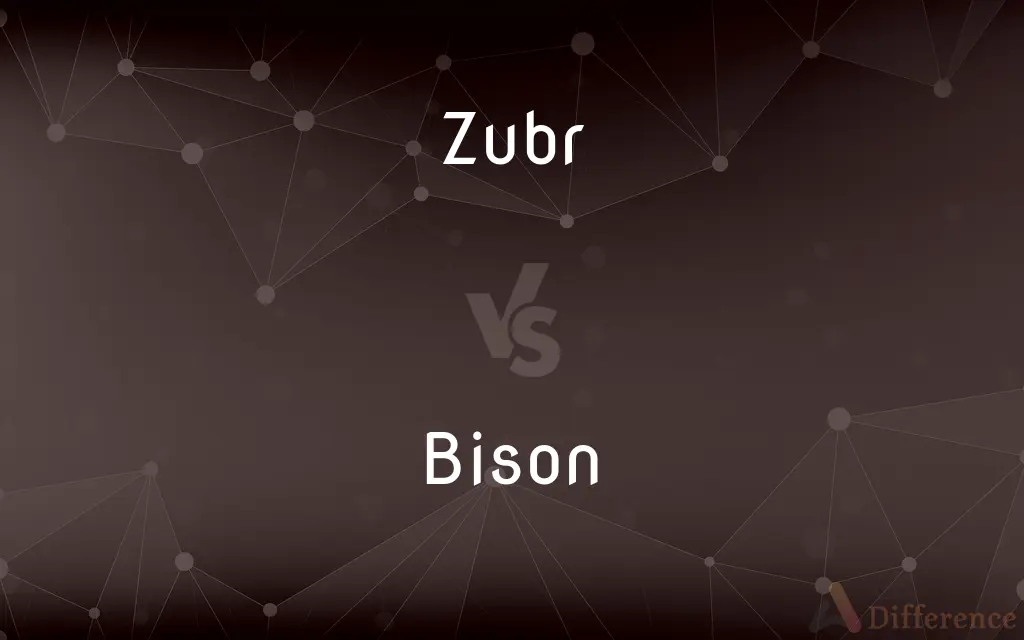Zubr vs. Bison — What's the Difference?
By Fiza Rafique & Urooj Arif — Updated on March 7, 2024
Zubr refers to the European bison, while Bison encompasses various species, including the American bison.

Difference Between Zubr and Bison
Table of Contents
ADVERTISEMENT
Key Differences
Zubr, or the European bison (Bison bonasus), is native to Europe and has a distinct appearance with a taller, less massive frame compared to its American counterpart. It's known for its lighter, more manageable mane and the significant hump at the shoulders. On the other hand, Bison typically refers to two main species: the American bison (Bison bison), which includes both the plains and wood bison subspecies, and is characterized by its more robust build, with a pronounced shoulder hump and larger head.
Habitat plays a key role in differentiating these species. Zubrs primarily inhabit the dense forests and meadows of Europe, where they play a crucial role in the ecosystem by maintaining open areas through grazing. Conversely, American bison were historically found in great numbers across the grasslands and prairies of North America, shaping the landscape and ecosystem through their grazing patterns.
Conservation status and history also differ significantly between the two. Zubrs were driven to near extinction by the early 20th century due to hunting and habitat loss, with restoration efforts leading to their reintroduction from captivity into the wild. American bison, once numbering in the millions, faced a similar fate due to extensive hunting in the 19th century, but conservation efforts have since helped restore their populations in protected areas and reserves.
Behavioral and social structures vary as well. European bison tend to form smaller herds and are known for their more solitary nature compared to American bison, which are more gregarious and form large herds, particularly during migrations and breeding seasons.
Cultural significance also sets them apart. European bison hold a symbolic place in European history and folklore, representing wilderness and strength. In contrast, American bison are deeply ingrained in the history and culture of many Native American tribes, symbolizing abundance and the harmony of nature.
ADVERTISEMENT
Comparison Chart
Species
Bison bonasus
Bison bison (includes plains and wood bison)
Habitat
Dense forests and meadows of Europe
Grasslands and prairies of North America
Size and Build
Taller, less massive frame, lighter mane
Robust build, pronounced shoulder hump, larger head
Conservation Status
Near extinction in early 20th century, reintroduced from captivity
Near extinction in 19th century, restored in protected areas
Social Structure
Smaller herds, more solitary
Large herds, gregarious
Cultural Significance
Symbol of European wilderness and strength
Integral to Native American culture, symbolizing abundance
Compare with Definitions
Zubr
The European bison, native to Europe.
The zubr roams freely in the Białowieża Forest.
Bison
Refers to species including the American bison.
The American bison roams the prairies of North America.
Zubr
Known for a lighter mane and less massive frame.
Observers can distinguish the zubr by its tall stature and lighter mane.
Bison
Hold significant cultural value for Native American tribes.
The bison symbolizes abundance and nature's harmony in Native American cultures.
Zubr
Conservation efforts have reintroduced them from near extinction.
Captive breeding programs have helped increase zubr populations.
Bison
Originally found in vast numbers across North America's grasslands.
Bison were crucial in shaping the ecosystem of American prairies.
Zubr
Symbolic in European history and folklore.
The zubr represents wilderness and strength in many European cultures.
Bison
Conservation efforts have helped restore populations.
Protected areas and reserves now support thriving bison herds.
Zubr
Habitats include dense forests and meadows.
Zubrs play a crucial role in maintaining open areas in European ecosystems.
Bison
Characterized by a robust build and large head.
The bison's pronounced shoulder hump is a distinctive feature.
Zubr
(obsolete) One of several species of European bison or aurochs, which were unclearly delineated in the 1800s when this sense was in use.
Bison
Bison are large, even-toed ungulates in the genus Bison within the subfamily Bovinae. Two extant and six extinct species are recognised.
Zubr
The wisent, the European bison (Bison bonasus).
Bison
A bovine mammal (Bison bison) of western North America, having large forequarters, a shaggy mane, and a massive head with short curved horns; a buffalo.
Zubr
The aurochs.
Bison
A bovine mammal (Bison bonasus) of Europe, similar to the American bison but with a somewhat smaller head and longer horns; a wisent.
Bison
The flesh of the American bison, used as food.
Bison
A large, wild bovid of the genus Bison.
Bison
The aurochs or European bison.
Bison
Any of several large shaggy-maned humped bovids having large heads and short horns
Common Curiosities
What is a zubr?
A zubr is the European bison, native to Europe, and known for its taller, less massive frame compared to the American bison.
How does the habitat of a zubr differ from a bison?
Zubrs typically inhabit dense forests and meadows of Europe, while American bison are found in the grasslands and prairies of North America.
What are the conservation statuses of zubrs and bison?
Both species were near extinction due to hunting and habitat loss, but conservation efforts have helped reintroduce zubrs and restore bison populations.
What is the cultural significance of a zubr in Europe?
The zubr holds symbolic importance in European history and folklore, representing wilderness and strength.
What role did American bison play in Native American culture?
American bison were central to many Native American tribes, symbolizing abundance and harmony with nature.
What efforts are being made to ensure the survival of these species?
Efforts include habitat restoration, legal protection, captive breeding, and reintroduction programs to ensure their long-term survival.
Are there different subspecies of American bison?
Yes, the American bison includes subspecies like the plains bison and wood bison, each with unique characteristics.
Can zubrs and bison interbreed?
While they are genetically similar, interbreeding is not common due to their geographical separation and conservation management practices.
How do the social structures of zubrs and bison differ?
Zubrs tend to form smaller herds and are more solitary, whereas American bison form large herds and are more gregarious.
How have zubrs been reintroduced into the wild?
Zubrs have been reintroduced through captive breeding programs and carefully managed releases into suitable habitats.
How are current populations of zubrs and bison maintained?
Current populations are maintained through protected areas, reserves, and ongoing conservation efforts to ensure their survival and genetic diversity.
How do zubrs and bison contribute to their ecosystems?
Both species play crucial roles in their ecosystems by maintaining open areas through grazing, which benefits a variety of plant and animal species.
How have human activities impacted zubrs and bison historically?
Both species were driven to near extinction due to excessive hunting and habitat destruction, highlighting the impact of human activities on wildlife.
What is the size comparison between a zubr and an American bison?
Zubrs are generally taller with a less massive frame, while American bison have a more robust build with a pronounced shoulder hump.
What challenges do conservationists face in protecting zubrs and bison?
Challenges include habitat loss, genetic diversity maintenance, and conflicts with human activities, necessitating comprehensive conservation strategies.
Share Your Discovery

Previous Comparison
Vocabulary vs. Glossary
Next Comparison
Attitude vs. OpinionAuthor Spotlight
Written by
Fiza RafiqueFiza Rafique is a skilled content writer at AskDifference.com, where she meticulously refines and enhances written pieces. Drawing from her vast editorial expertise, Fiza ensures clarity, accuracy, and precision in every article. Passionate about language, she continually seeks to elevate the quality of content for readers worldwide.
Co-written by
Urooj ArifUrooj is a skilled content writer at Ask Difference, known for her exceptional ability to simplify complex topics into engaging and informative content. With a passion for research and a flair for clear, concise writing, she consistently delivers articles that resonate with our diverse audience.














































